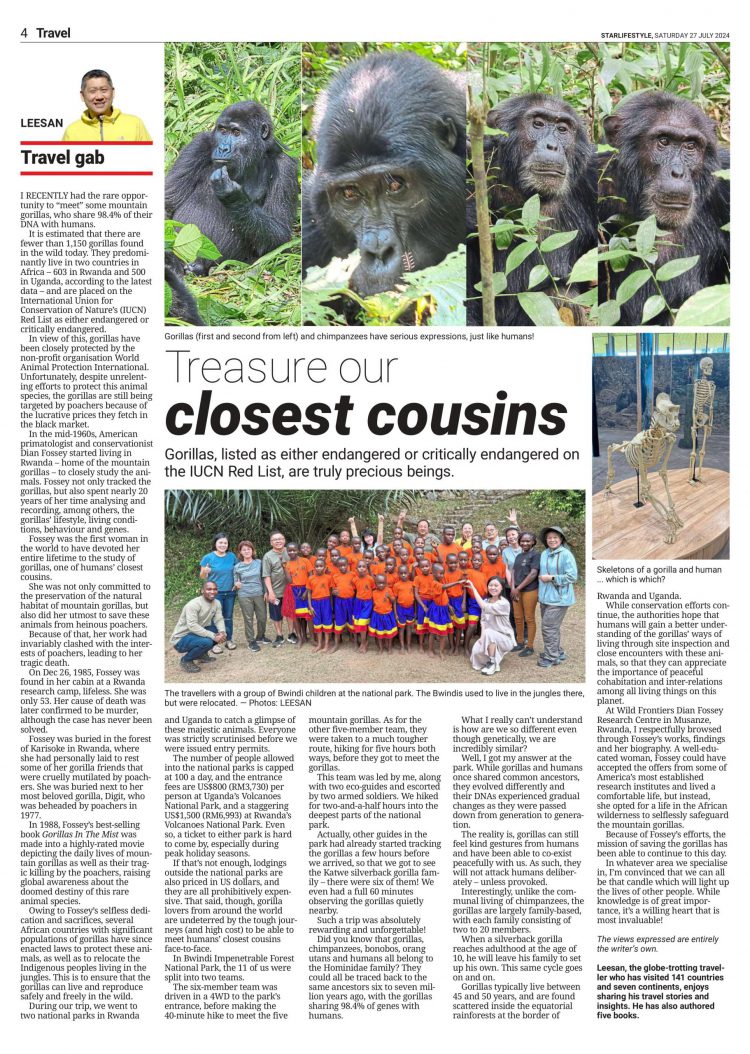Treasure our closest cousins – by leesan
Gorillas, listed as either endangered or critically endangered on the IUCN Red List, are truly precious beings.
I RECENTLY had the rare opportunity to “meet” some mountain gorillas, who share 98.4% of their DNA with humans.
It is estimated that there are fewer than 1,150 gorillas found in the wild today. They predominantly live in two countries in Africa – 603 in Rwanda and 500 in Uganda, according to the latest data – and are placed on the International Union for Conservation of Nature’s (IUCN) Red List as either endangered or critically endangered.
In view of this, gorillas have been closely protected by the non-profit organisation World Animal Protection International. Unfortunately, despite unrelenting efforts to protect this animal species, the gorillas are still being targeted by poachers because of the lucrative prices they fetch in the black market.
In the mid-1960s, American primatologist and conservationist Dian Fossey started living in Rwanda – home of the mountain gorillas – to closely study the animals. Fossey not only tracked the gorillas, but also spent nearly 20 years of her time analysing and recording, among others, the gorillas’ lifestyle, living conditions, behaviour and genes. Fossey was the first woman in the world to have devoted her entire lifetime to the study of gorillas, one of humans’ closest cousins. She was not only committed to the preservation of the natural habitat of mountain gorillas, but also did her utmost to save these animals from heinous poachers.
Because of that, her work had invariably clashed with the interests of poachers, leading to her tragic death. On Dec 26, 1985, Fossey was found in her cabin at a Rwanda research camp, lifeless. She was only 53. Her cause of death was later confirmed to be murder, although the case has never been solved.
Fossey was buried in the forest of Karisoke in Rwanda, where she had personally laid to rest some of her gorilla friends that were cruelly mutilated by poachers. She was buried next to her most beloved gorilla, Digit, who was beheaded by poachers in 1977. In 1988, Fossey’s best-selling book Gorillas In The Mist was made into a highly-rated movie depicting the daily lives of mountain gorillas as well as their tragic killing by the poachers, raising global awareness about the doomed destiny of this rare animal species. Owing to Fossey’s selfless dedication and sacrifices, several African countries with significant populations of gorillas have since enacted laws to protect these animals, as well as to relocate the Indigenous peoples living in the jungles. This is to ensure that the gorillas can live and reproduce safely and freely in the wild.

Gorillas (upper first and second) and chimpanzees have serious expressions, just like humans!
During our trip, we went to two national parks in Rwanda and Uganda to catch a glimpse of these majestic animals. Everyone was strictly scrutinised before we were issued entry permits. The number of people allowed into the national parks is capped at 100 a day, and the entrance fees are US$800 (RM3,730) per person at Uganda’s Volcanoes National Park, and a staggering US$1,500 (RM6,993) at Rwanda’s Volcanoes National Park. Even so, a ticket to either park is hard to come by, especially during peak holiday seasons. If that’s not enough, lodgings outside the national parks are also priced in US dollars, and they are all prohibitively expensive. That said, though, gorilla lovers from around the worldare undeterred by the tough journeys (and high cost) to be able to meet humans’ closest cousins face-to-face.

The travellers with a group of Bwindi children at the national park. the Bwindis used to live in the jungles there, but were relocated. — Photos: leesan
In Bwindi Impenetrable Forest National Park, the 11 of us were split into two teams. The six-member team was driven in a 4WD to the park’s entrance, before making the 40-minute hike to meet the five mountain gorillas. As for the other five-member team, they were taken to a much tougher route, hiking for five hours both ways, before they got to meet the gorillas. This team was led by me, along with two eco-guides and escorted by two armed soldiers. We hiked for two-and-a-half hours into the deepest parts of the national park.
Actually, other guides in the park had already started tracking the gorillas a few hours before we arrived, so that we got to see the Katwe silverback gorilla family – there were six of them! We even had a full 60 minutes observing the gorillas quietly nearby.
Such a trip was absolutely rewarding and unforgettable! Did you know that gorillas, chimpanzees, bonobos, orang utans and humans all belong to the Hominidae family? They could all be traced back to the same ancestors six to seven million years ago, with the gorillas sharing 98.4% of genes with humans.
What I really can’t understand is how are we so different even though genetically, we are incredibly similar?
Well, I got my answer at the park. While gorillas and humans once shared common ancestors, they evolved differently and their DNAs experienced gradual changes as they were passed down from generation to generation.
The reality is, gorillas can still feel kind gestures from humans and have been able to co-exist peacefully with us. As such, they will not attack humans deliberately unless provoked.
Interestingly, unlike the communal living of chimpanzees, the gorillas are largely family-based, with each family consisting of two to 20 members. When a silverback gorilla reaches adulthood at the age of 10, he will leave his family to set up his own. This same cycle goes on and on.
Gorillas typically live between 45 and 50 years, and are found scattered inside the equatorial rainforests at the border of Rwanda and Uganda.
While conservation efforts continue, the authorities hope that humans will gain a better understanding of the gorillas’ ways of living through site inspection and close encounters with these animals, so that they can appreciate the importance of peaceful cohabitation and inter-relations among all living things on this planet.

Dian Fossey’s love for gorillas is legendary.

Skeletons of a gorilla and human…which is which?
At Wild Frontiers Dian Fossey Research Centre in Musanze, Rwanda, I respectfully browsed through Fossey’s works, findings and her biography. A well-educated woman, Fossey could have accepted the offers from some of America’s most established research institutes and lived a comfortable life, but instead, she opted for a life in the African wilderness to selflessly safeguard the mountain gorillas.
Because of Fossey’s efforts, the mission of saving the gorillas has been able to continue to this day.
In whatever area we specialise in, in, I’m convinced that we can all be that candle which will light up the lives of other people. While knowledge is of great importance, it’s a willing heart that is most invaluable!

Published in The Star, 27 July 2024
全球超过80000家酒店,Apple101助您轻松订房,出行无忧,绝对优惠价。入住期间付款,多数客房可免费取消!











